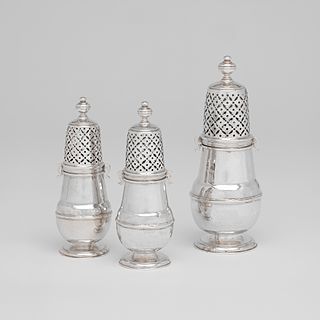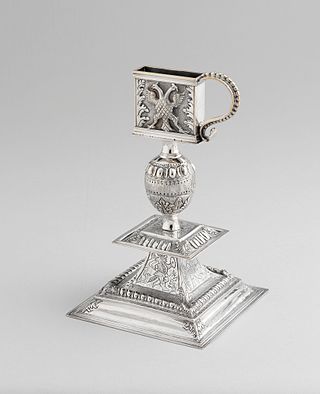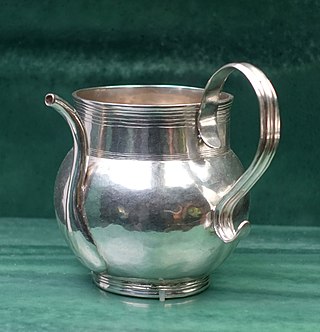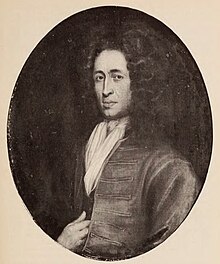
Jeremiah Dummer was a Massachusetts-born politician and writer who was an important figure in the New England Colonies during the early 18th century. His most significant contributions to American history were his A Defense of the New England Charters and his role in the formation of Yale College.

The pound was the currency of the Commonwealth of Massachusetts and its colonial predecessors until 1793. The Massachusetts pound used the £sd currency system of 1 pound divided into 20 shillings, each of 12 pence. Initially, sterling coin and foreign currencies circulated in Massachusetts, supplemented by pine tree shillings produced by John Hull between 1652 and 1682 and by local paper money as of 1690.
Events from the year 1718 in art.

Events from the year 1645 in art.
The silver Sapieha beaker is a 16th-century beaker, which originally belonged to Grygor Sapieha and was made in the Grand Duchy of Lithuania. The Sapieha family played an important role in Lithuania's history through much of the 16th century. In 2007 the beaker was auctioned at Christie's London for £132,500. At the time the purchaser remained anonymous.

John Hull was an English-born merchant, silversmith, slave trader and politician who spent the majority of his life in the Massachusetts Bay Colony. After arriving in North America, he worked as a silversmith in Boston before becoming the moneyer responsible for issuing the colony's pine tree shillings in the mid-17th century. Hull was also a successful merchant and engaged in slave-trading on multiple occasions. He was also an early benefactor of Harvard College and a co-founder of the Old South Church.
Rev. Shubael Dummer was an American Congregational church minister who was killed in the Raid on York in York, Massachusetts Bay Colony. Described as a man of "beautiful Christian character", Dummer founded the First Parish Congregational Church of York, the oldest church congregation in what is now the U.S. state of Maine.

John Coney was an American silversmith and goldsmith from Boston, Province of Massachusetts Bay. He specialized in engraving. From the 1690s on, Coney was considered the most important Bostonian silversmith of his day. In 1702, he engraved the paper money for Massachusetts. Coney also designed a version of the seal of Harvard College.

Colonel Edward Winslow was an American silversmith and military officer.

Nathaniel Hurd is recognized as the first American engraver and a silversmith in Boston, Massachusetts, in the 18th century. He engraved "bookplates ... heraldic devices, seals, ... paper currency, and business cards" along with die engravers and engravers on copper.

Adrian Bancker, also known as Adriaan or Adrianus Bancker, was a prominent silversmith in New York City.

Bartholomew Le Roux was an early American silversmith, active in New York City.

Cornelius Kierstede was a noted early American silversmith, active in New York City and New Haven, Connecticut.

William Cowell Sr. was a silversmith active in Boston in the Thirteen Colonies.

Thomas Charles Fletcher was a prominent American silversmith and merchant, active in Boston and Philadelphia. His firm of Fletcher & Gardiner was nationally renowned.

Samuel Haugh was an early American silversmith, active in Boston. Only three of his works are known to survive: two cups and a spoon.

Daniel Parker was an American silversmith, active in Boston.

Edward Webb was a Colonial American silversmith, born in England but active in Boston. He apprenticed from 1680 until 1687 to William Denny, a London goldsmith, and may have been in Boston as early as 1704, but definitely by 1709. His work is collected in the Five Colleges Art Museums, Metropolitan Museum of Art, Museum of Fine Arts, Boston, and Yale University Art Gallery.

Hans Jørgen Thorvald Christensen (1924–1983) was a Danish-born American master silversmith, metalsmith, jeweler, designer, and educator. In the second half of the 20th century, he was a major contributor to handcrafted silver design in the United States.

Marquand and Company was a U.S. silverware firm that was in business from 1804 to 1838.They specialized in intricate pieces of silver, such as tea services, tongs, pitchers, and trays. The company sold out of their specialty department store in New York City, as well as across the country. The Marquands, through their company, were able to amass a substantial fortune, allowing them to become major philanthropists. Frederick, for example, was instrumental in the founding of Pequot Library, while his brother Henry Gurdon Marquand played a pivotal role in establishing the Metropolitan Museum of Art.



















